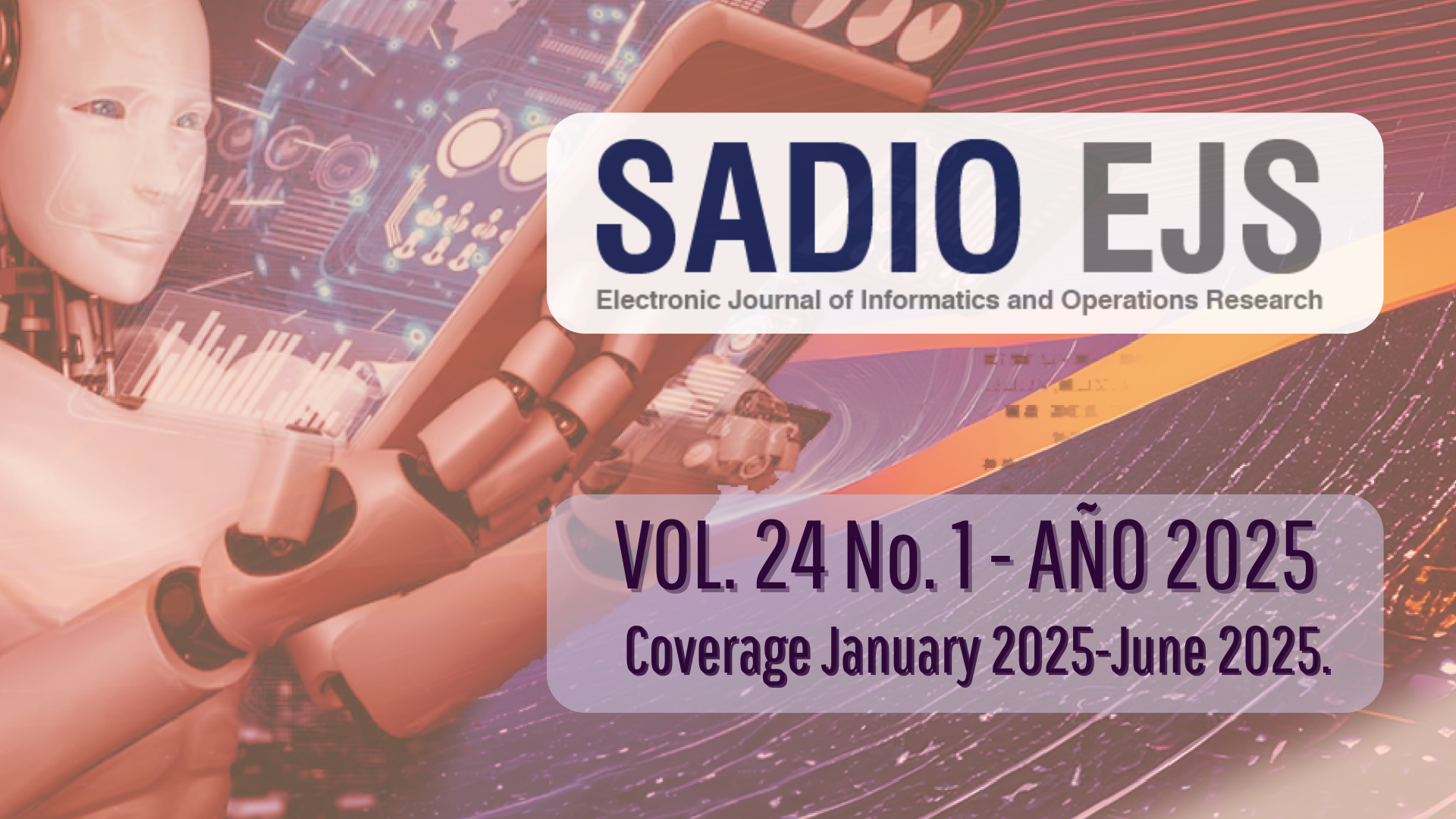Modelling and forecasting electricity demand: Comparing statistical and machine learning approaches
DOI:
https://doi.org/10.24215/15146774e067Keywords:
electricity demand forecast, weather conditions, deep learning, artificial neural networkAbstract
Reliable forecasting of electricity demand is essential for enhancing distribution system management by optimizing resource utilization, streamlining operational planning, and reducing service disruptions. The fluctuation of electricity demand is influenced by various external factors, such as weather conditions, yet the intricate and non-linear associations between demand and these influences present significant prediction challenges. In this study, we aim to forecast electricity demand by examining its relationship with weather variables in the province of Entre Ríos, Argentina. A recurrent neural network, specifically using long short-term memory (LSTM) architecture, is employed to model this complex relationship directly from raw input data without prior feature engineering. We assess and compare the performance of this model with a baseline method. Preliminary data analysis reveals that extreme temperatures exert a notable effect on energy consumption behaviors. Our proposed model achieves a coefficient of determination of 0.77 when comparing predicted demand to actual observations, underscoring its effectiveness as a potential solution for optimizing system operations in Entre Ríos.
Downloads
References
Pai, Hong, Forecasting regional electricity load based on recurrent support vector machines with genetic algorithms, Electric Power Systems Research, Volume 74, 3, 417-425, ISSN 0378-7796 (2005)
Barak, S. and S.S. Sadegh, Forecasting energy consumption using ensemble ARIMA– ANFIS hybrid algorithm. International Journal of Electrical Power & Energy Systems (2016). 82: p. 92-104.
Zhao, H.-x. and F. Magoulès, A review on the prediction of building energy consumption. Renewable and Sustainable Energy Reviews (2012). 16(6): p. 3586-3592.
Wang Y, Zhang N, Chen X, et al. A Short-Term Residential Load Forecasting Model Based on LSTM Recurrent Neural Network ConsideringWeather Features. Energies. 14(10):2737. (2021)
Wan He. Load Forecasting via Neural Networks. Procedia Computer Science. Volume 122. Pages: 308-314. ISSN 1877-0509. (2017) https://www.sciencedirect.com/science/article/pii/S1877050917326170 https://doi.org/doi:10.1016/j.procs.2017.11.374
Ekonomou, L., Oikonomou, D.S.: Application and comparison of several artificial neural networks for forecasting the Hellenic daily electricity demand load. In: Proceedings of the 7th WSEAS International Conference on Artificial Intelligence, Knowledge Engineering and data bases, pp. 67–71. World Scientific and Engineering Academy and Society (WSEAS) (2008).
Wang, J.M., Liang, X.H.: The forecast of energy demand on artificial neural network. In: Artificial Intelligence and Computational Intelligence. AICI’09. International Conference. vol. 3, pp. 31—35. IEEE Computer Society, Washington, DC, United States (2009)
Kavaklioglu, K.: Modeling and prediction of Turkey’s electricity consumption using Support Vector Regression. Appl. Energy (2011). 88(1), 368–375
Ghalehkhondabi, I., Ardjmand, E., Weckman, G.R. et al. An overview of energy demand forecasting methods published in 2005–2015. Energy Syst (2017). 8, 411–447. https://doi.org/doi:10.1007/s12667-016-0203-y
Rivenson, Y., Zhang, Y., Günaydın, H. et al. Phase recovery and holographic image reconstruction using deep learning in neural networks. Light Sci Appl 7, 17141. (2018) https://doi.org/doi.org/10.1038/lsa.2017.141
Belthangady, C., Royer, L.A. Applications, promises, and pitfalls of deep learning for fluorescence image reconstruction. Nat Methods (2019). 16, 1215–1225. https://doi.org/doi.org/10.1038/s41592-019-0458-z
Pereira, T.D., Aldarondo, D.E., Willmore, L. et al. Fast animal pose estimation using deep neural networks. Nat Methods (2019). 16, 117–125. https://doi.org/doi.org/10.1038/s41592-018-0234-5
M. M. Sachin and Melvin Paily Baby and Abraham Sudharson Ponraj. "Analysis of energy consumption using RNN-LSTM and ARIMA Model", Journal of Physics: Conference Series. (Dec, 2020) vol.1716, n°1, sp. 012048. https://doi.org/dx.doi.org/10.1088/1742-6596/1716/1/012048
P. Vincent, H. Larochelle, Y. Bengio, and P. Manzagol, Extracting and composing robust features with denoising autoencoders, in Proc. 25th Int. Conf. Mach. Learn. (ICML’08) , pp. 1096—1103. Association for Computing Machinery, New York (2008)
R. Sharda, R.B. Patil, Neural networks as forecasting experts: an empirical test, in:Proceedings of the International Joint Conference on Neural Networks, Washington, D.C., Vol. 2 (1990), pp. 491– 494.
Z. Tang, C. Almeida, P.A. Fishwick, Time series forecasting using neural networks vs Box–Jenkins methodology, Simulation 57 (1991) 303–310.
Z. Tang, P.A. Fishwick, Feedforward neural nets as models for time series forecasting, ORSA J. Comput. 5 (1993) 374–385.
Brockwell, P. J., & Davis, R. A. Introduction to time series and forecasting (3a ed.). Springer, New York (2016) https://doi.org/10.1007/978-1-4757-2526-1
Adamowski, J., Fung Chan, H., Prasher, S.O., Ozga-Zielinski, B., Sliusarieva, A.: Comparison of multiple linear and nonlinear regression, autoregressive integrated moving average, artificial neural network, and wavelet artificial neural network methods for urban water demand forecasting in Montreal, Canada. Water Resources Research 48(1) (2012)
Q. Gao, Y. Liu, J. Yang, and Y. Hong, Çomparative Research on Electricity Consumption Forecast Based on Deep Learning" 2nd International Conference on Artificial Intelligence and Education (ICAIE), Dali, China. (2021) pp. 213-217. https://doi.org/doi:10.1109/ICAIE53562.2021.00052
Junior Clony, Gusmão Pedro, Moreira José and Tome Ana Maria M. Time Series Forecasting in Retail Sales Using LSTM and Prophet. Handbook of Research on Applied Data Science and Artificial Intelligence in Business and Industry Copyright. Pages: 22 ISBN13: 9781799869856.ISBN10: 1799869857.EISBN13: 9781799869863. (2021) https://doi.org/doi:10.4018/978-1-7998-6985-6.ch011
Magallanes-quintanar, R., Galván Tejada C., Galván Tejada, J., and Gamboa-Rosales, H., and Méndez-Gallegos, S. and Garcia, Antonio. Neural Hierarchical Interpolation for Standardized Precipitation Index Forecasting. Atmosphere. Vol. 15. Pages 912. (2024) https://doi.org/=doi:10.3390/atmos15080912
R. Jozefowicz, W. Zaremba and I. Sutskever, An empirical exploration of recurrent network architectures, in: Int. Conf. Mach. Learn, pp. 2342-–2350. Association for Computing Machinery, New York (2015) https://doi.org/doi:10.1109/CVPR. 2015.729876
Gutiérrez, E. La demanda residencial de energía eléctrica en la Comunidad Autónoma de Andalucía; un análisis cuantitativo. Tesis de Doctorado. Facultad de Ciencias Enconómicas y Empresariales, Universidad de Sevilla (2003).
Medina, S.; García, J. Predicción de demanda de energía en Colombia mediante un sistema de inferencia difuso neuronal. Revista Energética 33,15-24. (2005).
Murillo, J; Trejos, A. Carvajal, P. Estudio del pronóstico de la demanda de energía eléctrica utilizando modelos de series de tiempo. Scientia et Technica (2003) 23, 37-42.
Kingma, D. P., Ba, J. Adam: A method for stochastic optimization. arXiv preprintarXiv:1412.6980. (2014) Retrieved from https://arxiv.org/abs/1412.6980
Downloads
Published
Issue
Section
License
Copyright (c) 2025 Mariela Uhrig, Leandro Vignolo, Omar Müller

This work is licensed under a Creative Commons Attribution-NonCommercial-ShareAlike 4.0 International License.
Those authors who have publications with this journal, agree with the following terms:
a. Authors will retain its copyright and will ensure the rights of first publication of its work to the journal, which will be at the same time subject to the Creative Commons Atribución-NoComercial-CompartirIgual 4.0 Internacional (CC BY-NC-SA 4.0) allowing third parties to share the work as long as the author and the first publication on this journal is indicated.
b. Authors may elect other non-exclusive license agreements of the distribution of the published work (for example: locate it on an institutional telematics file or publish it on an monographic volume) as long as the first publication on this journal is indicated,
c. Authors are allowed and suggested to disseminate its work through the internet (for example: in institutional telematics files or in their website) before and during the submission process, which could produce interesting exchanges and increase the references of the published work. (see The effect of open Access)





















